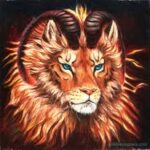Those of you who follow me on twitter (@GrimbyTweets) may have noticed my habit of posting links to a webcomic called Angeldevil every Friday. Perhaps you’ve followed them. Perhaps you’ve read what you’ve found there. Perhaps not.
This Friday I’m posting the first chapter of the last volume of Angeldevil, and the last page of Angeldevil will be posted December 31st. With the end so near, I’d like to take a moment to tell you about it.
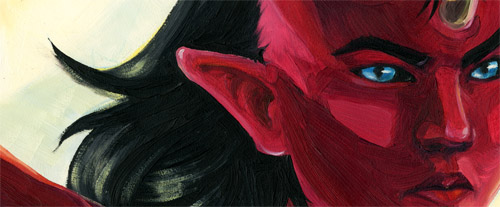
Angeldevil began in a doodle in my sketchbook on August 14th, 2004—the day before I turned seventeen. This doodle was a short cartoon featuring the two main characters, Matsuné and Shakuro, and can be considered the comic’s first incarnation. Designs for Shakuro’s character, however, and the concept of the “Angel-devil” (a human soul in a demon body) date back as far as 2003.
In retrospect I don’t know what I was thinking. “Drawing a manga will be fun!” probably. I didn’t think of the sheer amount of work writing, illustrating and publishing a comic would be. I couldn’t possibly know. I do know now, and I think my ignorance allowed me to be brave enough to embark on the project.
In the beginning I thought of Angeldevil as a learning experience. I wanted to teach myself how to make comics, and I felt the best way to do this was to actually make one. As a result, the first fifty chapters or so show a steep incline in the quality of the art—and a certain maturation of the writing style. The earliest chapters are downright amateur, and I can’t look at them now without flinching inwardly. But it’s partly because I drew them that I can now produce pages like this:
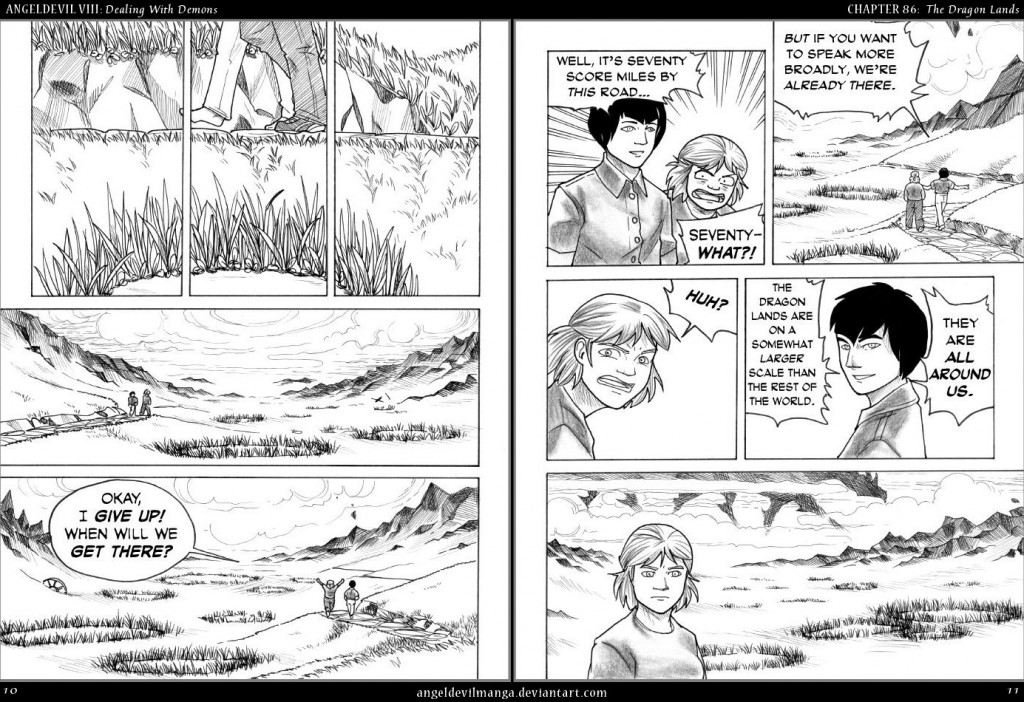
I have, at times, thought about going back and re-drawing the earlier chapters, to bring them in line with the overall quality of the series. But each time I come up against the limitations of my time and energy, and also the fact that I think we artists have a bad habit of hiding our ugly-duckling first attempts, contributing to the commonly held assumption that skilled artists spring fully formed into being, without ever having passed through an unsteady learning stage. For this very reason I think it’s important not to hide my early efforts. They are as much a part of my artistic landscape as the things I do now. Indeed, they are the foundation of it.
(But note, I do not provide an imbedded sample here. I am not without shame.)
I wrote Angeldevil around a strictly structured frame: 19 pages plus the cover for each chapter, eleven chapters per volume, and the entire series was to fall within eleven volumes. I did it this way specifically so I could pace the production on a steady schedule: instead of writing a script and then sketching and inking one page at a time, I would block out a chapter, then sketch all the pages, then clean them up, then ink them. Having such a structure was in some ways limiting, but also helped me self-edit as I went along. When you only have 20 pages to advance the story a set amount, you learn fast to distinguish what does and does not need to be shown. Because unlike straight prose, it doesn’t work to do the comic and then go back and edit it. Writing is fast. Drawing is slow. You cannot afford to spend five hours drawing a scene and then go back and decide to cut it. Similarly, it is impossible to add scenes after the fact, again because of the drawing. Even if I had the time, I worked in traditional media, which drastically reduced the amount of post editing I could do.
I say I wrote Angeldevil, but the truth is I did not write it as one would write a novel, or even a script. In the beginning I wrote it as I drew each page. This was time consuming, and as the story grew more complex I began to keep running notes about characters and plot points, even sketching out thumbnails for future pages ahead of time. This eventually developed into the method I would use the write the better part of the comic, and all the other comics I’ve done: start with a sheet of paper and do thumbnails for an entire chapter; little miniature pages with frames and images blocked out, and dialogue scribbled in the margins. The running notes eventually ballooned into a blow-by-blow for each chapter, with occasional lines of importance written down. But the detail of the notes varied from chapter to chapter, and up until the very end there were chapters that I fleshed out as I did the thumbnails. I never had a point-by-point script to work from. I literally wrote the comic with words and pictures at the same time.
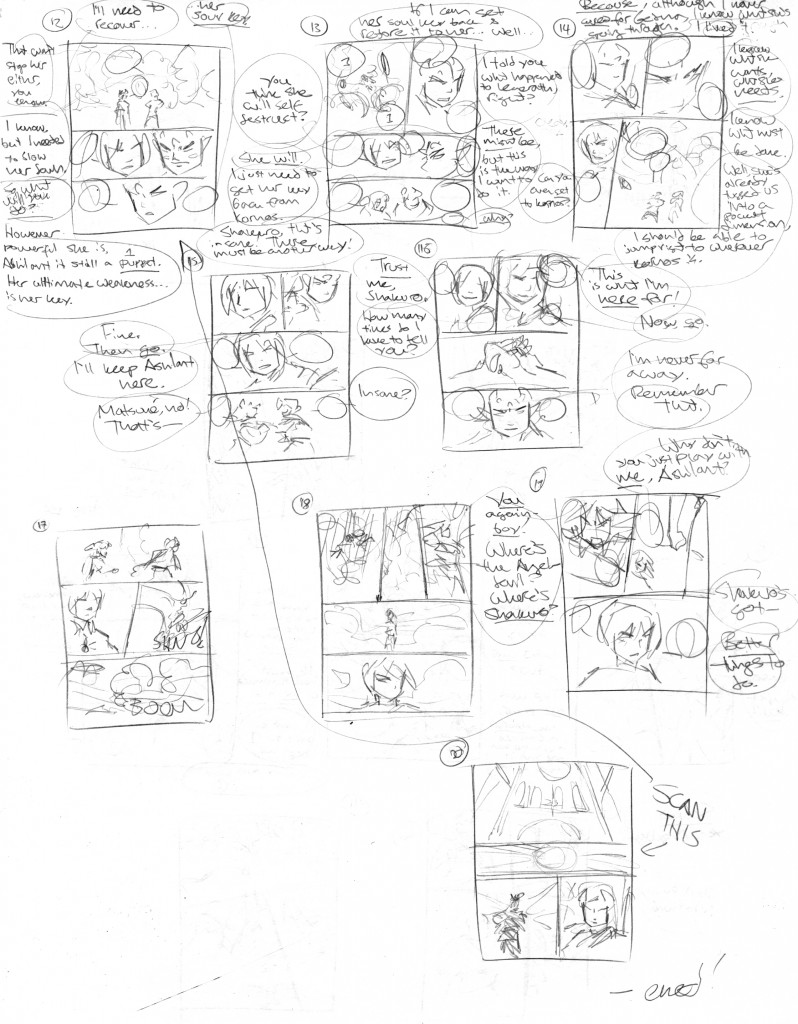
One of the most useful skills I acquired from seven years of writing/drawing Angeldevil was the ability to put out a lot of artwork over a short amount of time. People have remarked at how fast I draw (a friend of mind nicknamed me “Lightning Pencil”) but this is no accident. I had to draw this fast in order to get four pages sketched in under two hours. Now I can say with near-perfect accuracy exactly how long it will take me to do a comic of any given length.
I’ve also learned how to tell stories with words and pictures, which is distinctly different than telling a story with just words. You have to think about camera angles, how to show time in space, how to convey action. Certain things translate better visually, others verbally. Knowing how to play the strengths of a visual media off the strengths of prose is definitely a balancing act, and one that is just not necessary when writing straight prose. Yet simply knowing that it exists has, I think, made my writing better. Because to draw something you must visualize it with absolute clarity (after all, you’re drawing it), and, not surprisingly, having a clear image in your head makes your writing that much stronger too. (Note: it doesn’t always make it easier to write; this author has lost many hairs whilst trying to translate a visually active scene into prose.)
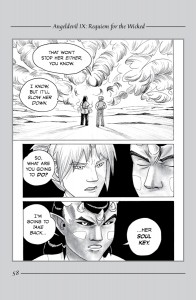
In February of 2008 I began posting Angeldevil online through the website deviantart.com. This added a new dimension of work: typesetting. Because I did not ink my dialogue, after I’d scanned the pages in I had to go back and digitally erase my sloppy penciled text and replace it with digital type. In doing so I did manage to subtly smooth out some of the early writing—though the confines of word balloons restricted how much I could change. As I was also developing the comic for print books I had to figure out what I was to do about the cropping. In the early pages I would place the frames right up next to the edge of the paper, but with printing you need half an inch to an inch of dead space around the important artwork to allow for slippage and cropping. Also, the aspect ratio of the paper I had been working with was different from standard comic book dimensions. The solution I found was to place the entire page within a frame that extended to the very edge of the paper. The result was somewhat unusual for a comic, though it did have the advantage allowing me room for a running header, and of preserving the entire drawing, so nothing was cropped.
As my art style evolved over the course of the comic, so did the tools I used to create it. Though I never found anything better than Sharpie markers for doing large areas of black, I was continually trying out different types of pen for the thin lines. However, until Volume 11 the media didn’t change too much.
I produced the raw artwork for Volume 11 during the fall and early winter of 2011. It being the climactic end to a saga over a hundred chapters long (for those keeping count, that’s over two thousand individual pages) I wanted to do something special. So I decided to make it all in color.
Color adds a whole new dimension to comics. You’re not just dealing with shapes and shades of gray, you now have hues to work with as well. And although I had been doing color covers for every volume (in oils, no less!) rendering the entire comic in color added significant mental effort.
Also, coloring something in takes over twice as long as inking it in black. So for the last five chapters of Angeldevil I chose to paint in watercolor—the fastest colored medium I use.
Watercolor, I’ve decided, is great for comics. It’s fast, flexible, and expressive. It’s also relatively cheap, portable, and compatible with paper. But the switch to watercolor was still a big leap for me: I had developed methods for speeding up the inking process that could not be applied to watercolors, and in a way I was back to square one. Except I was a much better watercolorist at the end of 2011 than I was ever an illustrator in 2004. And getting to see these characters that had grown and developed along with myself over the past seven years finally rendered in full color was like seeing them come to life all over again.
This is the part where I would show you an example of what my watercolor pages look like, but the fact is I haven’t posted any of them yet. Chapter 111, the first full-color chapter, goes up tomorrow over on deviantART. But I can show you the cover for Volume 11:
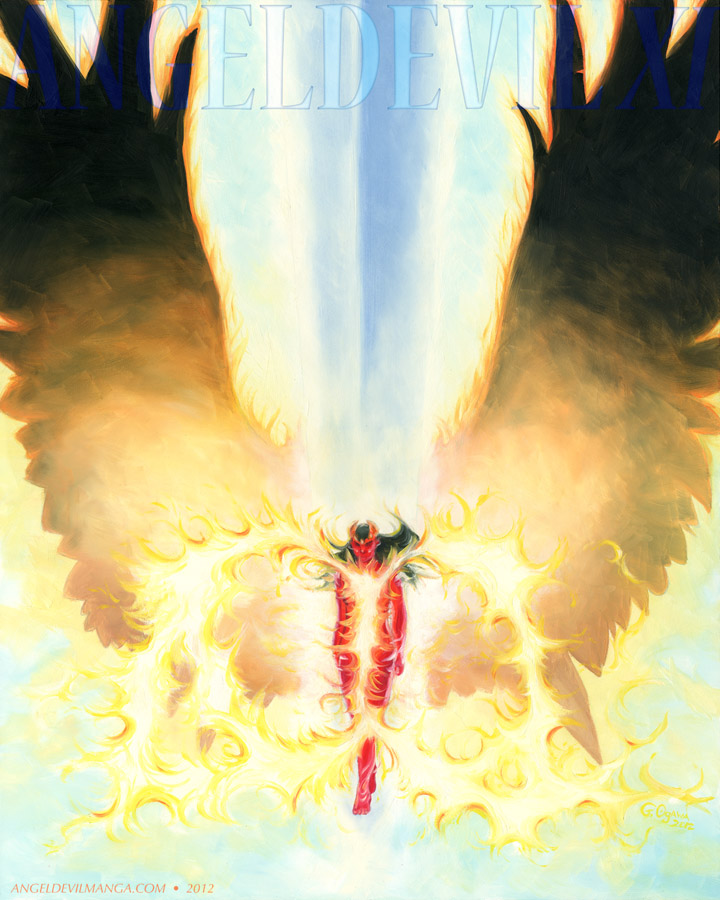
While the first nine volumes of Angeldevil are available PoD style through Lulu and the entire series up to the end of Volume 10 is available online, if you want to follow the ending of Angeldevil without losing twelve hours to a comics marathon, I have put together a series recap as a promo for Volume 11 which summarizes the story nicely. It is in two parts on deviantART here and here and the entire, 28,000 pixel-tall original image can be found here.
I’ve found that many people immediately associate comics with either the Sunday Funnies, or super-heroes in tight pants. I find this perplexing. Comics (or manga as they are called in Japan), are just another medium for telling stories, like novels, movies, television shows and plays. And just like the others they have their own unique set of strengths and weaknesses.
Some stories work better as straight prose, and some stories work better through illustrated prose, and some not only work better, but indeed can only work in that strange, hybrid environment of words and pictures that is the comic medium.
I like to think that Angeldevil is one of those stories. Certainly it’s not a story I could ever have written as a novel. One thing is for certain: I can now say with confidence that I know how to make a comic.
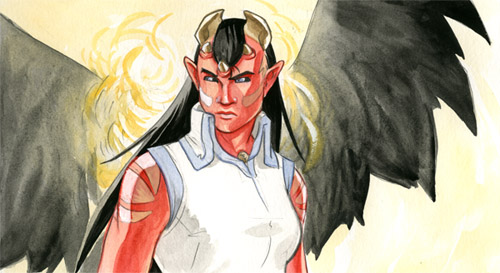
Goldeen Ogawa considers herself more of a writer than an artist; but only just. In addition to Angeldevil she has also produced two color comic books about the character Tobius Leander, available from Rabbit Valley Comics, and was the co-creator (with her brother) of the webcomic The Iron Wizard (Completed in 2010). She is currently working on an all-new webcomic, Year of the God-Fox, also in watercolor, coming next year. You can email her at goldeenogawa@gmail.com or peck at her on Twitter @GrimbyTweets.
